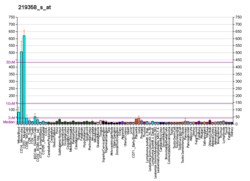| ADAP2 |
|---|
|
| Identifiers |
|---|
| Aliases | ADAP2, CENTA2, HSA272195, cent-b, ArfGAP with dual PH domains 2 |
|---|
| External IDs | OMIM: 608635; MGI: 2663075; HomoloGene: 10179; GeneCards: ADAP2; OMA:ADAP2 - orthologs |
|---|
| Gene location (Human) |
|---|
 | | Chr. | Chromosome 17 (human)[1] |
|---|
| | Band | 17q11.2 | Start | 30,906,344 bp[1] |
|---|
| End | 30,959,322 bp[1] |
|---|
|
| Gene location (Mouse) |
|---|
 | | Chr. | Chromosome 11 (mouse)[2] |
|---|
| | Band | 11 B5|11 47.56 cM | Start | 80,154,105 bp[2] |
|---|
| End | 80,178,958 bp[2] |
|---|
|
| RNA expression pattern |
|---|
| Bgee | | Human | Mouse (ortholog) |
|---|
| Top expressed in | - monocyte
- synovial membrane
- amniotic fluid
- granulocyte
- placenta
- spleen
- trabecular bone
- gingival epithelium
- blood
- synovial joint
|
| | Top expressed in | - Rostral migratory stream
- right kidney
- stroma of bone marrow
- lumbar subsegment of spinal cord
- left lobe of liver
- human kidney
- jejunum
- blastocyst
- duodenum
- proximal tubule
|
| | More reference expression data |
|
|---|
| BioGPS |  | | More reference expression data |
|
|---|
|
| Gene ontology |
|---|
| Molecular function | - inositol 1,3,4,5 tetrakisphosphate binding
- protein-macromolecule adaptor activity
- phosphatidylinositol-4,5-bisphosphate binding
- protein binding
- phosphatidylinositol-3,4,5-trisphosphate binding
- metal ion binding
- GTPase activator activity
- phosphatidylinositol-3,4-bisphosphate binding
- phosphatidylinositol bisphosphate binding
| | Cellular component | - cytoplasm
- plasma membrane
- mitochondrial envelope
- membrane
| | Biological process | - heart development
- positive regulation of GTPase activity
| | Sources:Amigo / QuickGO |
|
| Orthologs |
|---|
| Species | Human | Mouse |
|---|
| Entrez | | |
|---|
| Ensembl | | |
|---|
| UniProt | | |
|---|
| RefSeq (mRNA) | |
|---|
NM_001346712
NM_001346714
NM_001346716
NM_018404 |
| |
|---|
| RefSeq (protein) | |
|---|
NP_001333641
NP_001333643
NP_001333645
NP_060874 |
| |
|---|
| Location (UCSC) | Chr 17: 30.91 – 30.96 Mb | Chr 11: 80.15 – 80.18 Mb |
|---|
| PubMed search | [3] | [4] |
|---|
|
| Wikidata |
| View/Edit Human | View/Edit Mouse |
|



















